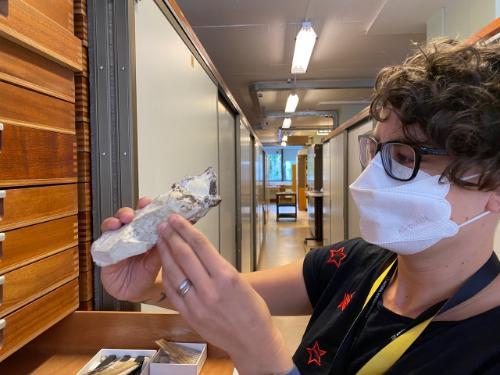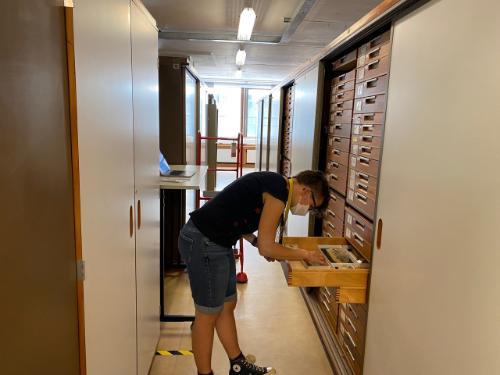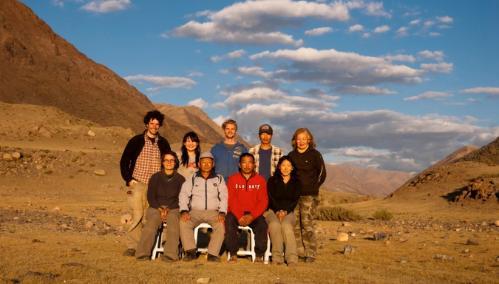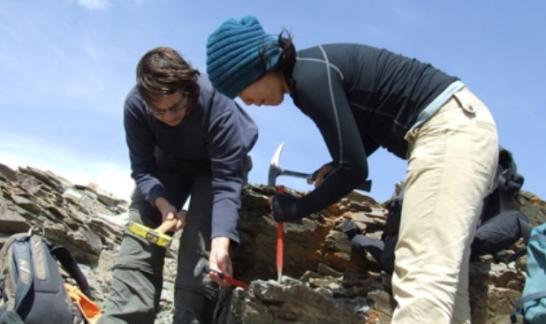Sam Giles
Dr Sam Giles - Ask a Palaeontologist

This month we chat to Sam Giles, Research Fellow at the University of Birmingham.
- Name: Sam Giles
- Job: Research Fellow
- Location: University of Birmingham
What inspired you to become a scientist?
Growing up, I liked reading – I never thought of science as something I really wanted (or was able) to do. At school I liked geography, and my GCSE teacher told me that my favourite parts of the subject (volcanoes and glaciers) were actually geology, so I studied that at college and really enjoyed it. I applied for geology at university on a whim, really!
What inspired you to become a palaeontologist?
When I was a geology undergraduate student I was looking for a paid summer job, and one of my palaeontology lecturers was able to fund me to do a research internship. My job was to pick through thousands of fossil bone fragments and look for tiny teeth or jaws. We then took these fossils to a synchrotron in Switzerland: this is a big particle accelerator that spins electrons round a ring really fast, and uses the energy that this produces to look at the internal structure of specimens. I loved this taste of research, and applied to do future projects with my lecturer, and eventually a PhD.
Describe your work/job.
I am a senior research fellow, which means that I spend the majority of my time carrying out independent research. I use CT scanning to investigate the anatomy and evolution of fossil fishes. CT scanning works just like getting an x-ray at a hospital: the x-rays pass through the fossil and you can use the different compositions of the rock and fossilised tissues to look at the parts of the fossil that are buried in rock. I work on the early evolution of jawed and bony fishes, trying to understand how they are related to each other and what drove them to become so successful. I also supervise PhD students, do some teaching, and sit on a number of committees and councils.
What’s the best part of your job?
I absolutely love dissecting anatomy from CT data. There’s something about being the first person to ever see the internal structure of a fossil that’s hundreds of million years old and buried inside rock!
What other jobs have you done?
I’ve worked in small shops, but I was very lucky as an undergraduate student to get a bursary and paid summer research internships that meant I didn’t need to work outside the university during my degree.
What were your favourite subjects at school?
History and English Literature.
Where did you study geoscience/palaeontology?
I did my undergraduate degree at the University of Bristol and my PhD at the University of Oxford.
What hobbies do you have outside of palaeontology?
I like to read a lot – mostly fantasy books, and the longer the better. I also like road cycling and playing with my family and our dogs.

What is your favourite fossil?
Oooh, tough one. I can’t choose!
What’s your favourite place that you have travelled to study palaeontology?
Just before starting my PhD I was incredibly lucky to be invited to do fieldwork in Mongolia. I spent six weeks working with an international team of Mongolian, Canadian, Swedish and Dutch researchers.
 Why is it important for us to study palaeontology?
Why is it important for us to study palaeontology?
Partly just because it’s fun! But also because it tells us about how past life has evolved and responded to ecological and environmental crises.
What advice would you give to somebody interested in becoming a palaeontologist?
Try and figure out what you’re interested in. Palaeontology isn’t just about digging up fossils: it’s everything from analysing huge datasets, coding to understand evolution and extinction, and reconstructing anatomical changes on hundreds-of-millions-of-years timescales.
A Day in the Life of Sam Giles
09.00
If I’m not working from home I commute to work on the train, so after dropping my kids off at school I spend ~45 minutes on the train. I use this time to catch up on emails and work out my plan for the day. If the train isn’t too busy and I’m not too tired I’ll also use this time to do some writing (e.g on a manuscript or paper review), and continue this once I get to my office.
11.00
I try and meet with the PhD students I work with at least once a week, although I have a general policy that I am around as and when I’m needed rather than having a strict one hour slot This might involve checking the CT scans they’re working in, looking through lab work results, helping to describe anatomy, or checking a manuscript they’re writing. If not, there may be a university meeting or teaching prep I need to do.
13.00
After lunch I may work on some CT data or figures. Or emails…
15.00
Mid-late afternoon is when my brain kicks in, so I like to use this time for writing. One day a week I finish work before 3 so that I can pick my kids up from school (rather than them going to after school club) and spend some time with them.
17.00
I leave to get the train home shortly before 5. I might work on my emails on the train, or read a book. Once I’m home I will cook tea, or play with my kids if my partner is cooking.
19.00
Get the kids in bed, walk the dogs if they haven’t been out yet today, tidy the house. I almost never work in the evenings (or on weekends), except for a couple of hours on the one day a week that I finish work at 3pm.
Sam online
- Follow Sam on Twitter - @GilesPalaeoLab


